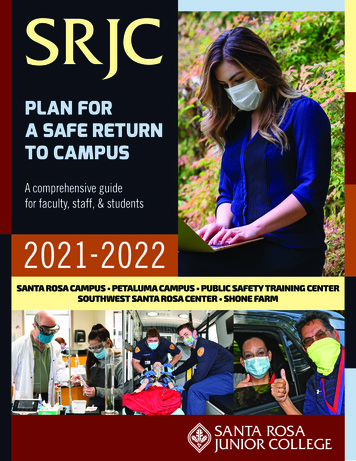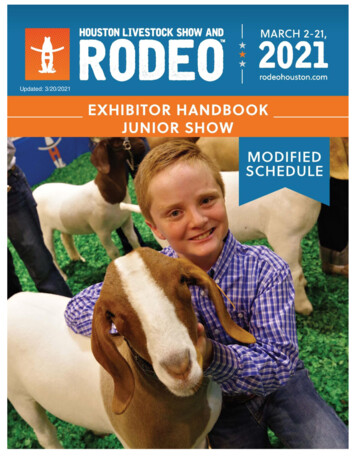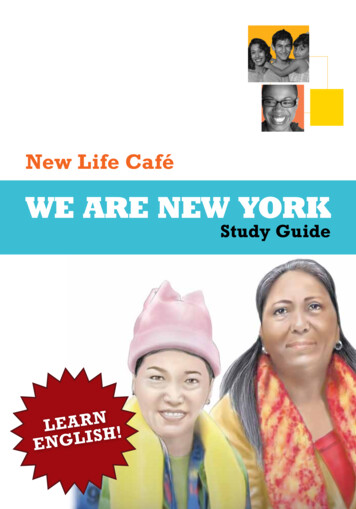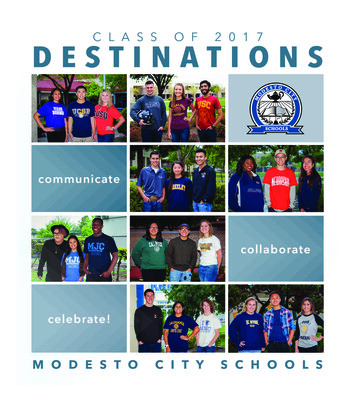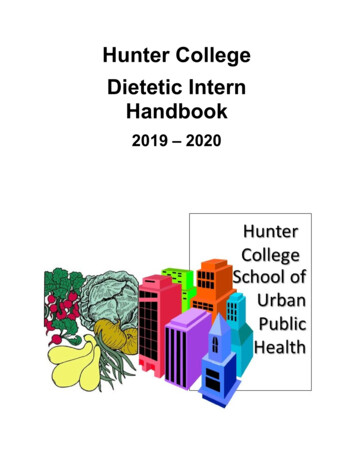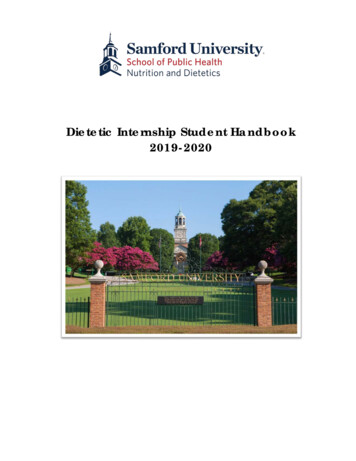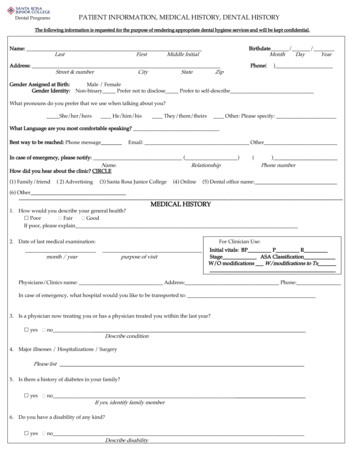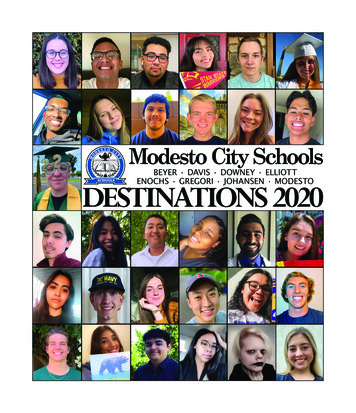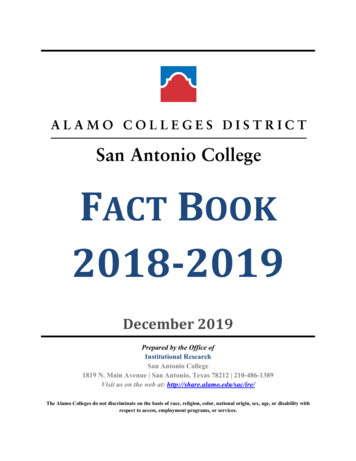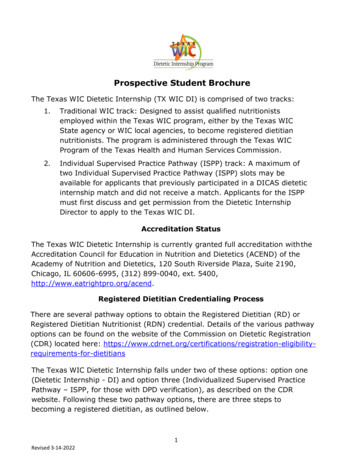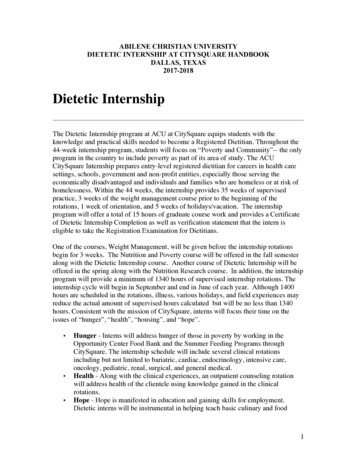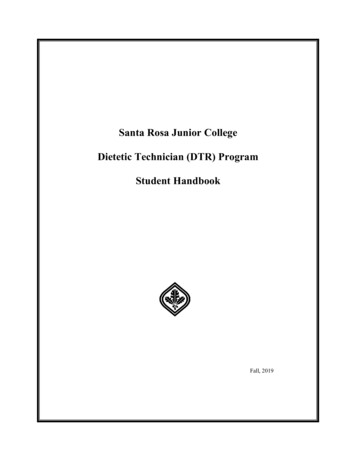
Transcription
Santa Rosa Junior CollegeDietetic Technician (DTR) ProgramStudent HandbookFall, 2019
Table of ContentsWELCOME and Program Contact Information 2Program Description and InformationDietetic Technician Program Mission, Goals and Outcome Measures 4Program Student Learning Outcomes 5Required Program Courses and Proposed Sequence for the Major 6Requirements for Progression in the Program 6Supervised Field Experience: Goals, Requirements and Responsibilities 7Supervised Field Experience: Student Competency Evaluations . 8Documenting DTP Competency Completion – Student Portfolio 92017 Dietetic Technician Program (DTP) Accreditation Competency Standards .10Guidelines for Handling Training-Related Injury/Exposure to Hazardous Substances .14Workers Compensation Information for Dietetic Program Students . .14Program Communication Channels . 15Program Estimated Expenses . 16Dietetic Technician, Registered Credentialing ProcessCommission on Dietetic Registration DTR Testing and Credentialing Process 17Dietetic Technician Registration Exam Information: Content Domains and Topics 18General SRJC Student Information . 20Application Information . 20Assessment – English and Math Placement Tests . . 20Counseling . . 21Financial Aid Contact Information . 21Class Registration Information . 21Disability Resources . 21Adult Re-Entry Services 21Student Health Services Information . 22SRJC Academic Integrity Statement 24Sexual Harassment Information . 24SRJC Student Standards of Conduct – Guidelines and Due Process . 25SRJC Student Grievance Procedures . . . . 26Supervised Field Experience Client Confidentiality Policy and Agreement 28Dietetic Technician Program Statement of Understanding and Compliance Agreement . . 29SRJC Dietetic Technician Student Handbook, Fall 20191
WELCOME and Program Contact InformationWelcome to the Santa Rosa Junior College Dietetic Technician Program. This handbook was developed toprovide information about SRJC in general and the Dietetic Technician Major Program in particular. Weappreciate all ideas about materials that should be included, and encourage you to make suggestions forimprovement. The information in this handbook is effective for the current academic year.Dietetic Technician Major Program FacultyFoods and Nutrition Program FacultyHealth Sciences DepartmentSanta Rosa Junior CollegeContact Information:Dietetic Technician Program:Jill Tarver, MS, RDDietetic Technology Program Coordinator(707) 521-6921jtarver@santarosa.eduDietary Service Supervisor Program:Jill Harrison, RDDietary Service Supervisor Program Coordinator(707) 521-6947jharrison@santarosa.eduFoods Nutrition Program:Tammy Sakanashi, MS, RDFoods Nutrition Program Coordinator(707) 522-2711tsakanashi@santarosa.eduWebsite: https://healthsciences.santarosa.edu/DIETETIC TECHNICIAN PROGRAM:Santa Rosa Junior College’s (SRJC) Dietetic Technician Program (DTP) has been granted full accreditation forAccreditation by the Accreditation Council for Education in Nutrition and Dietetics (ACEND), the accreditingagency for the Academy of Nutrition and Dietetics (AND). This program is designed to provide the academiccoursework and skill based competency training that will allow students to be eligible to take, and successfullypass, the certification exam of the Commission on Dietetic Registration (CDR) to become DieteticTechnicians, Registered (DTR) and work as entry-level DTRs in the field of Nutrition, Dietetics, and/orFoodservice Management. In addition, we offer coursework that can help prepare students for transfer to afour-year college program to complete requirements to become a Registered Dietitian (RD). (See Nutrition andDietetics transfer major for RD preparation.)DTRs, trained in food and nutrition, are integral members of teams in health care, business and industry, publichealth, foodservice, and research. At SRJC, training focuses on health care where DTRs will workcooperatively with Registered Dietitians to screen clients for nutritional risk, assist in their nutritional care, andsupervise food production and service.In California, a “Dietetic Technician Registered” is legally defined through a Scope of Practice law (Businessand Profession Code Section 2585-2586.8), which requires that Dietetic Technicians be registered by theCommission on Dietetic Registration, the credentialing agency of the Academy of Nutrition and Dietetics(CDR/AND), 120 South Riverside Plaza, Chicago, IL, 60606-6995, phone 312-899-0040.SRJC’s DT program provides the following qualifications for registration eligibility:1.Associate degree from a US regionally accredited college2.Successful completion of an ACEND-accredited didactic DT (Dietetic Technician) program and3.Completion of 450 hours of supervised practice within an ACEND-accredited DT programDT Program graduates can become registered when they have completed all program requirements, includingpassing all required DT Major courses with a grade of C or better and documenting all ACEND competenciesSRJC Dietetic Technician Student Handbook, Fall 20192
for entry level DTRs, receive a verification statement of requirement completion, and have passed the CDR’sRegistration Exam for Dietetic Technicians. See page 10 of this handbook for a list of all ACEND DTcompetencies. See pages 15-17 of this handbook for more information about the CDR exam.Courses required for the DT program will be scheduled during the Fall and Spring semesters. Information about thestarting and ending dates for each semester as well as any dates for which the college will be closed and/or classes willnot be held is printed in the Santa Rosa Junior College’s Schedule of Classes and is available online athttp://www.santarosa.edu/schedules/academic calendar/Graduates of an ACEND/AND accredited Didactic Program in Dietetics, with an original verification statement andofficial transcript, may be able to waive some requirements for the Dietetic Technician major. See the DieteticTechnician Program Coordinators for information.Foreign Credential EvaluationsSanta Rosa Junior College is unable to evaluate college coursework completed outside the United States. Privatecredential evaluation services provide this service for a fee. The fee for this service can range from 100 - 200 perevaluation. Prior to using any evaluation service, you should determine the purpose of your request. You may wish tocontact an SRJC Academic Counselor at (707) 527-4451 to assist you with this decision.SRJC recognizes lower division coursework that meets the requirements for an Associate Degree. We are unable tocertify foreign coursework for the CSU GE (California State University General Education Pattern) or IGETC(Intersegmental General Education Transfer Curriculum) pattern for the CSU and UC systems. Students who plan totransfer to a four-year college or university after attending SRJC should be aware that these schools may not accept theforeign credential evaluation; they will review your course work according to their own evaluation criteria. Pleasecontact the SRJC Evaluations Office at (707) 527-4517 for further information.The list below provides contact information for companies that evaluate transcripts from outside the US. SRJC does notendorse or recommend any particular company, but does accept evaluations performed by these companies.Academic Credentials Evaluation InstituteP.O. Box 6908Beverly Hills, CA 90212(800) 234-1597 email: acei@acei1.comwww.acei1.comAcademic & Professional International Evaluations, Inc.P.O. Box 5787Los Alamitos, CA 90721-5787(562) 594-6498 email: APIE@email.msn.comwww.apie.orgEducation Credential Evaluators, Inc.P.O. Box 514070Milwaukee, Wisconsin 53203-3470(414) 289-3400 email: eval@ece.orgwww.ece.orgInternational Education Research Foundation, Inc.P.O. Box 3665Culver City, CA 90231-3665(310) 258-9451 email: information@ierf.orgwww.ierf.orgCenter for Applied Research Evaluation &Education Inc.P.O. Box 20348Long Beach, CA 90801(562) 430-8215 email: evalcaree@earthlink.netWorld Education Services, Inc.P.O. Box 5087Bowling Green StationNew York, NY 10274-5087(212) 966-6311 email: info@wes.org www.wes.orgThe credential evaluation report submitted to SRJC should include the following information: Lower/upper division course recommendations Course titles and descriptions (if possible) School calendar system Units (credits) and grades Accreditation credentials of school or universitySRJC requires a copy of your official transcript in addition to the report before credit can be awarded.Kh, A&R Rev 3/04SRJC Dietetic Technician Student Handbook, Fall 20193
Dietetic Technician Program Mission, Goals and Outcome Measures:Mission:The Mission of the Dietetic Technician Program at SRJC is to provide both academic and experiential learningenvironments that prepare graduates to be competent entry-level dietetic technicians.Goal #1:The DTP will prepare students to be competently employed as Dietetic Technicians, Registered, in the field of nutrition,dietetics, foodservice, or a related field, or to be continuing with education at a higher level.Outcome Measures:Upon completion of the DTP, students will have a portfolio documenting acquisition of the knowledge, skills, andcompetencies of entry level Dietetic Technicians.1. The overall DTP completion rate will be 75% or greater within 5 years of enrolling in the program.2. Over a five-year period, at least 80% of eligible graduates will, within one year of program completion:A. sit for the DTR exam orB. be enrolled in a higher level of education.3. Over a five-year period, the pass rate for program graduates taking the registration examination for the firsttime will be at least 80%.4. Over a five-year period, 70% or more of program graduates who seek employment in nutrition, dietetics, orfoodservice will be employed within three months of program completion.5. Over a five-year period, 70% or more of program graduates who are employed in nutrition, dietetics orfoodservice will be meeting or exceeding employer expectations.The Program will survey local employers annually to collect information about the knowledge, skills, and overall workbased competency levels of our program graduates in the areas of nutrition, dietetics, and/or foodservice. Surveyresponses will have an average rating of competent or above.Goals #2:The Program will prepare graduates for active participation in the profession of nutrition, dietetics or foodservicemanagement.Outcome Measures:Over a five-year period, at one-year post graduation, at least 25% of survey respondents who are employed in nutrition,dietetics or foodservice will bea) active participants in a local, state, or national professional organization and/orb) involved as mentors or preceptors for students in nutrition, dietetics, and/or foodserviceOver a five-year period, at two-year post graduation, at least 50% of employed graduates responding to surveys will beactively involved as mentors and/or preceptors for students in nutrition, dietetics and/or foodservice.Program graduates will be surveyed at one and two year post graduation. Efforts will be made to follow up with nonrespondents to try to achieve 100% survey response.SRJC Dietetic Technician Student Handbook, Fall 20194
STUDENT LEARNING OUTCOMES forSRJC DIETETIC TECHNICIAN PROGRAMUpon successful completion of the Santa Rosa Junior College Dietetic Technician Program the student willdemonstrate the knowledge, skill and ability to:1.Take and pass the Commission on Dietetic Registration (CDR) Exam for Dietetic Technicians,Registered (DTR) or be prepared to continue education in nutrition, dietetics, or foodservice at ahigher level.2.Communicate clearly and professionally as a Dietetic Technician, Registered, in written andverbal formats.3.Apply basic knowledge of nutrition and physiology in assisting individuals with health promotionand disease prevention.4.Prepare nutritional care plans for and provide counseling to clients from diverse cultural and socialbackgrounds at various stages in the lifecycle.5.Manage cost control, purchasing, inventory, meal production, employee scheduling andsupervision of foodservice workers for safe and sanitary commercial food production.6.Use leadership skills to motivate employees to work as a team in an efficient and effective mannerthat meets or exceeds client expectations.7.Exhibit professional behaviors in all aspects of work as competent DTRs.8.Meet workforce needs for DTRs.SRJC Dietetic Technician Student Handbook, Fall 20195
Required Program Courses and Proposed Sequence for the Dietetic Technology MajorSemesterSemester 1Semester 2Semester 3Semester 4TotalCourse Number and Course TitleUnitsSemFDNT 10*:Elementary NutritionDIET or FDNT 70: Introduction to Nutrition, Dietetics and Food ServiceDIET 50:Sanitation and SafetyLIR 10*:Introduction to Information LiteracyPHYSIO 58:Intro to Human PhysiologyEnglish 1A or equivalent*DIET 57:Modified Diets (Pre-requisite: FDNT 10)DIET 176:Applied Diet TherapyFDNT 75:Principles of FoodsCOUN 91 or DIET 191:Counseling and Group Facilitation Skills in HealthcarePSYCH 1A*:General PsychologyHumanities, American Institutions, or American Cultures GE class*DIET 55:Food Production ManagementDIET 55L:Food Production Management LabDIET 106.1:Supervised Field Experience, Semester 1(Pre-requisites: DIET 50, 57, 176, FDNT/DIET 70 COUN 91/DIET 191)Humanities, American Institutions, or American Cultures GE class*(Fulfillment of Math competency requirement for AS* if not already met) **DIET 52:Management Training TechniquesDIET 106.2:Supervised Field Experience, Semester 2(Pre-requisites: DIET 50, 57, 176, FDNT/DIET 70 COUN 91/DIET 191)COMM 66* or SPCH 60*: CommunicationANTHRO 2* or 30*: Cultural AnthropologyHumanities, American Institutions, or American Cultures GE class*Total SXFFF3*3*34.5FSXFSXSS3*3*3*62 **FSXFSXFSXF Fall; S Spring; X Summer* This course partially satisfies General Education requirement for Associate Degree.** A minimum of 60 units is required for the Associate Degree award. If any requirement, such as mathcompetency, is met without course completion, elective course(s) must be completed to meet the 60 unit minimum.REQUIREMENTS FOR PROGRESSION IN THE PROGRAMStudents must complete placement tests for Math and for English and/or have satisfied the Associate degreerequirement for both Math and English prior to being considered enrolled in the DT program.All courses must be completed within the last five years and must be passed with a letter grade of “C” or higher.Progression in the program requires successful completion of all courses and prerequisites. Courses identified by theProgram Coordinator as being equivalent or higher can be used to fulfill program requirements for the purposes ofgraduation and verification of DTR eligibility. Example: Physiology 1 can be substituted for Physiology 58,Speech 1A for Speech 60, LIR 30 for LIR 10.Applicants who have completed required courses within the last five years will be given credit. Applicants who havecompleted required courses more than five years ago may request a waiver of program policy on the basis of currentknowledge. Current knowledge may be demonstrated by:1. Recent verified work experience in nutrition, food service or a closely related field.2. Higher level courses completed within the last five years for which the required DT course was aprerequisite, e.g. completion of Psych 1A more than five years ago and completion of more advancedPsychology course within the last five years.Upon completion of all program requirements, including completion and documentation of all ACEND Diet Techcompetencies, students will receive a verification statement of program completion to document eligibility to sit forthe CDR registration exam for DTRs, a requirement to work as a dietetic technician in the state of California.SRJC Dietetic Technician Student Handbook, Fall 20196
SUPERVISED FIELD EXPERIENCE (SFE): Goals, Requirements and ResponsibilitiesPURPOSE: Field experience is a valuable means for applying course material to work situations outsidethe classroom. Through observations and “hands on” experiences, students will become more competent inthe area studied and be able to share various means of dietary management used in the field. SupervisedField Experience is for the educational benefit of the DT student only, and is not intended to meet the laborneeds of the facility nor substitute for or replace the work of employees. (Fair Labor Standards Act)GOALS:1. To reinforce knowledge of the health care and non-health care nutrition and dietetics environments andthe functioning of these services within the health care system and other agencies.2. To provide opportunities for application of knowledge and skills and development of competenciesexpected of entry level Dietetic Technicians with a variety of clients in a variety of settings, includingfoodservice management, clinical nutrition, and health promotion in the community.3. To introduce students to additional knowledge and skills as practiced by those currently employed inthe fields of Nutrition and Dietetics.STUDENT RESPONSIBILITIES:1. General: As a Santa Rosa Junior College student enrolled in our Dietetic Technology Program, youreflect and will influence the ongoing relationship between your field sites and our college, programand students. In addition, your work performance influences your long-term employment potential!Therefore, your professional conduct at all field sites is expected; your questions to help ensure thateach field experience meets its intended objectives are welcomed; and your constructive, professionalfeedback to your field preceptor, instructor and/or the program coordinator are appreciated.2.Pre-placement clearances: Students are required to abide by the policies of the clinical facility anddietary department while at the field site. When in doubt, ask your field preceptor about any specificpolicies or interpretations of policy.TB Test: Students are required to have proof of a screening test for TB, before starting SFE rotations.Immunizations: Requirements vary by site, check with instructor PRIOR to beginning of SFE.Physical Exam: Some Supervised Field Experience rotations require proof of a physical in the last year.SRJC Student Health Services (SHS): TB screening is available through SHS. Other required health screenings andimmunizations may also be available through SHS. Check with SFE facility and then SHS for more details:www.santarosa.edu/for Background Check and Fingerprinting: Prior to beginning Supervised Field Experience, all students musthave a background check with Verify Students www.verifystudents.com and fingerprinting completed.See program coordinators for details.3.Identification: You are required to carry/wear a SRJC identification card with your photograph on allSupervised Field Experience rotations. www.santarosa.edu/for students/student resources/cybear/4.Transportation: Students are required to furnish transportation to and from the field experience facility.Some SFE may require student to commute outside of Santa Rosa, including up to 100 miles, one way.5.Liability: Santa Rosa Junior College agrees to provide coverage by Workmen’s Compensation andprofessional liability insurance while students are training at the assigned Clinical Agency.6.Attendance: Students will sign a Memo of Understanding for the required number of hours of SFE fora course at the beginning of the term (semester) of enrollment. Late arrivals and/or early departuresfrom the assigned site could adversely affect your course grade, your ability to complete the DTprogram requirements, and SRJC’s long-term relationship with the facility.a)You are expected to be in your facility on time and to stay for the assigned/agreed upon time.b)If you must be absent for an excusable reason, call the facility as soon as possible prior to yourscheduled time and let your preceptor or other designated contact know of your expected absence.c)Report any change of schedule to the program coordinator as soon as possible.d)Keep an accurate record of actual time spent in the field and at home with assignments. Preceptorwill sign off on the time record throughout the rotation and at the conclusion of the rotation.SRJC Dietetic Technician Student Handbook, Fall 20197
7.STUDENT RESPONSIBILITIES, continued:Dress: Dress code for field experiences will depend on the assigned site. Abide by the facility'sstandards regarding colors of clothing, street clothes vs. uniforms, etc. As is standard in food service,students must wear closed-toed, non-skid soled shoes, and must have a hair net or other hair restraintas required by the facility. No dangling jewelry or other accessories of this type may be worn.8.Objectives: It is your responsibility to complete all of the objectives for the field experience. Reportany problems at least two weeks prior to the completion of your rotation.9.Reports: You will be required to complete a “Clinical Notebook” documenting work for each rotation,In addition, forms for each scheduled assignment must be completed and signed by the field sitepreceptor (RD or designee at the field site). Documentation of competency achievement, includingwork samples and self-assessment, must be kept in your student portfolio until the ProgramCoordinator verifies completion of all program requirements.10. Learn and enjoy!!ADDITIONAL INFORMATION FOR PRECEPTORS AND STUDENTS:1. The first session should include, or be used exclusively, as a general orientation to the facility. At thistime, all students beginning their rotation at the facility can be present at one time for more efficientuse of preceptor (or employee designated by him or her) time.2.Please allow the students ACTUAL, PRACTICAL, HANDS-ON EXPERIENCE as much aspossible, as time and experience/competence of each student permits.3.Clean, appropriate attire and hairnet when working in foodservice are requirements for each student.Students will check with each facility preceptor for additional specific instructions.4.Students and preceptors will review their prepared lists of objectives BEFORE each field experience.Each will know what is to be accomplished during each session. If there is a conflict of interest, thepreceptor's choice will take precedence. At the completion of each student rotation, preceptor willcomplete and sign “Dietetic Technician Competency Evaluation” form and meet with student toreview the completed form.5.Students will bring objective workbook and all finalized written work to the facility each meeting time.All written work must be neat, organized, and readable. Use ink or type/word processing. Completedwork from Supervised Field Experiences will make up part of the student portfolio, reviewed at thetime of the exit interview for the program for verification purposes.SUPERVISED FIELD EXPERIENCE (SFE): Student Competency Evaluations1. Written course objectives will be provided to both students and preceptors for each course. Studentstrengths and areas for improvement will be periodically identified to provide each student theopportunity for further development or improvement during the field experience courses. Theseevaluations are intended to help ensure that students are maintaining a complete portfolio documentingprogram progress and are prepared for entry-level work by the conclusion of the DT program.2.At appropriate times in each rotation, usually midway, individual conferences will be held withstudents to discuss progress towards competency achievement (see “Documenting Competencies”,below). The course instructor will conduct student evaluations with input from field experiencepreceptors, student self-evaluation, and instructor evaluation.3.A final evaluation will be written and signed by both instructor and student and placed in the student’sfile. An evaluation conference with each student for the purpose of discussing the supervised fieldexperience evaluation will be conducted.4.If the student fails to meet with the instructor for the evaluation conference, a copy of the evaluationwill go in the student’s file noting that student did not meet with the instructor.SRJC Dietetic Technician Student Handbook, Fall 20198
Documenting CompetenciesA. Students will submit a portfolio documenting completion of each of the current competencies for entry-levelDietetic Technicians (see list of competencies, below). Each competency must be addressed on a separate pageas follows. (Abbreviated entries are provided as examples)1. Write out number and competency description directly from competency list.Examples:a. CNDT 3.3 Provide nutrition and lifestyle education to well populationsORb. CNDT 3.2 Perform specific activities of the Nutrition Care Process as assigned by registered dietitiannutritionists in accordance with the Scope of Nutrition and Dietetics Practice for individuals, groupsand populations in a variety of settings.2. Date and Facility at which competency was demonstrated. (some competencies may require more than one)3. Purpose and goal of selected activity, including description of target client or populationExamples:a. Develop educational material for a target population to help promote intake of iron-rich foods. Ichose grade school parents and snacks with high iron contentORb. Perform nutrition screening on patients to assist the RD with identification of high risk patients4. Description – Describe the activity that took place.Examples (include more detail, but start with basic description):a. I developed a flyer with colorful graphics that focused on high iron snack foods for childrenb. I screened an elderly Hispanic woman diagnosed with Type 2 Diabetes who had recently beenadmitted to a long term care facility5. Outcome/Evaluation: What happened? Was the activity successful in reaching your goal? What would youdo to make it better next time? Include self-evaluation of your skill level related to this competency.Examples:a. The flyer was distributed at back to school night. Positive feedback was received from severalparents; many asked for a Spanish version. Putting information in both English and Spanish wouldhave made it useful for more parents. (goal was partly met).b. I interviewed client for food likes and dislikes and did a calorie count of one day’s food intake. Onconsultation with the RD, we planned to meet with client to assess her understanding of foods thatwould be best for managing her diabetes. Labwork indicated that this was a medium risk client.I’m confident in my ability to collect data from a variety of clients and to complete a calorie count.6. Place samples/examples behind the related competency. If material applies to more than one competency,place notation with the 2nd competency indicating location of backup material.Examples:a. Place a flyer sample behind the documented competency along with an estimate of how manyflyers were taken, how many people saw/used the flyer or other information documenting theactivity. Include estimate of expenses.b. For all individual client interviews, include copy of Nutrition Care Plan, chart notes, or otherrelevant material after striking all confidential information, such as patient name and/oridentification number, before leaving the facility.B. The preceptor will evaluate the documented competencies to verify accuracy of activity and to assess the skilllevel as described on the SFE Competency Signature Form. The preceptor will critique the work prepared bythe student and the student will make any recommended/ necessary changes before considering the projectcompleted.C. The instructor will review student documentation, evaluate quality of work presented, and verify that thecompetency was met. The instructor will assess each recorded competency based on quality of work, completepresentation of required material documenting skill level, and write up of learning experience, INCLUDINGSTUDENT SELF-EVALUATION. The instructor will assess if the competency activity meets all parts of theintended learning outcome (some competencies have multiple parts). Students may need to repeat activitiesrelated to a competency to improve proficiency or better align learning with intent. All competencies must bedocumented for program completion and receipt of verification statement, which is required to take the DTRexam.SRJC Dietetic Technician Student Handbook, Fall 20199
ACEND 2017 Accreditation StandardsKnowledge Requirements and CompetenciesFor the NDTREffective June 1, 2017The program’s curriculum must be designed to ensure the breadth and depth of requisite knowledge and skillsneeded for entry-level practice as a nutrition and dietetics technician, registered.a.The program’s curriculum must include the following required components of the program’s curriculum,including prerequisites:1.General understanding of the scientific basis of nutrition and dietetics, exposure to research literatureand application to technical practice2.Oral and written communication skills sufficient for entry into technical practice3.Principles and techniques of effective interviewing and education methods for diverse individualsand groups4.Governance applicable to the technical level of nutrition and dietetics practice, such as the Scope ofNutrition and Dietetics Practice and the Code of Ethics for the Profession of
Santa Rosa Junior College's (SRJC) Dietetic Technician Program (DTP) has been granted full accreditation for . IL, 60606-6995, phone 312-899-0040. SRJC's DT program provides the following qualifications for registration eligibility: 1. Associate degree from a US regionally accredited college . Semester UnitsCourse Number and Course .
